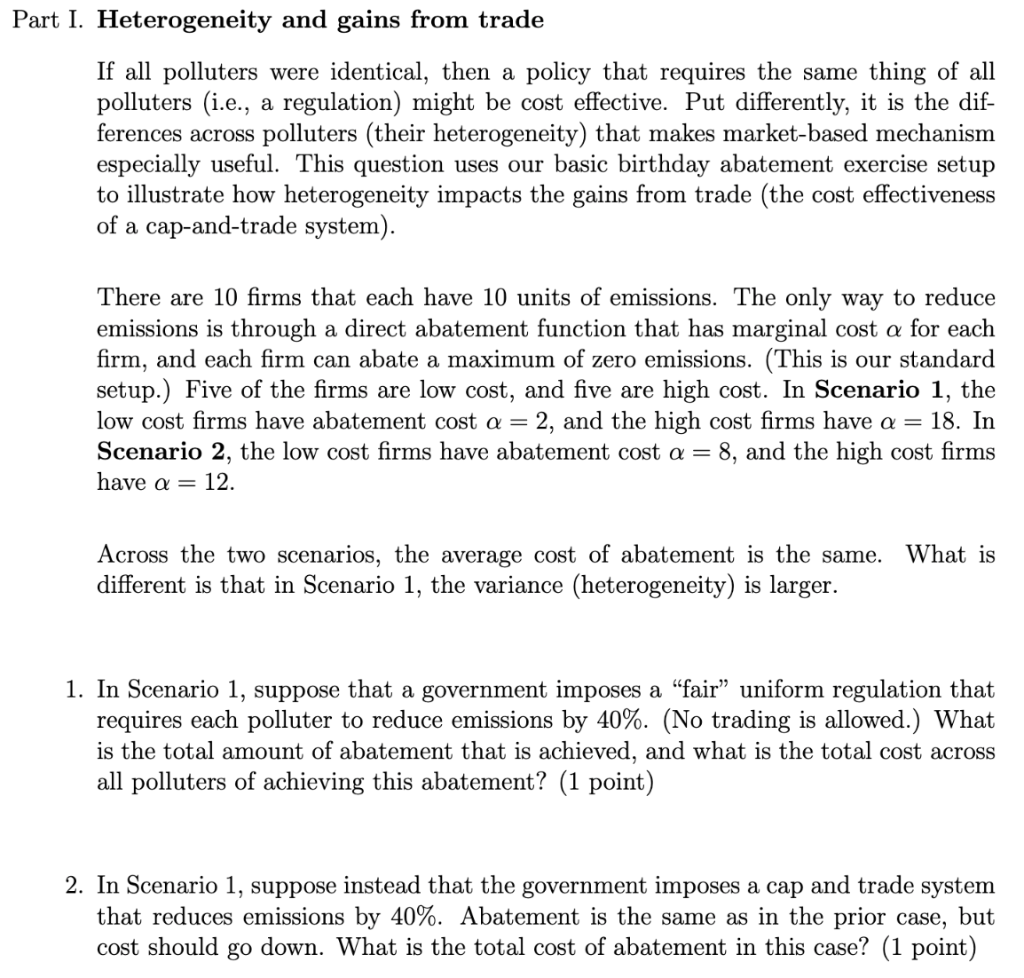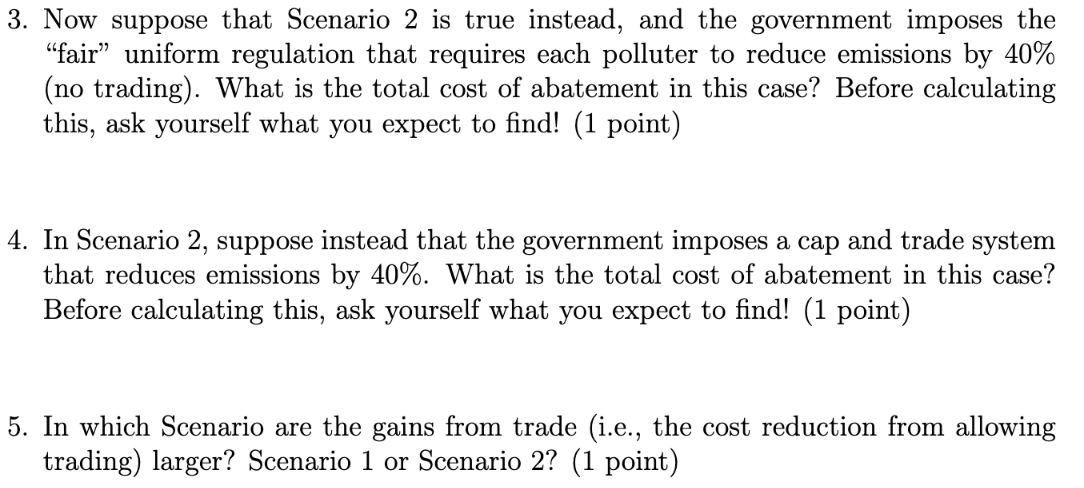

Part I. Heterogeneity and gains from trade If all polluters were identical, then a policy that requires the same thing of all polluters (i.e., a regulation) might be cost effective. Put differently, it is the dif- ferences across polluters (their heterogeneity) that makes market-based mechanism especially useful. This question uses our basic birthday abatement exercise setup to illustrate how heterogeneity impacts the gains from trade (the cost effectiveness of a cap-and-trade system). There are 10 firms that each have 10 units of emissions. The only way to reduce emissions is through a direct abatement function that has marginal cost a for each firm, and each firm can abate a maximum of zero emissions. (This is our standard setup.) Five of the firms are low cost, and five are high cost. In Scenario 1, the low cost firms have abatement cost a = 2, and the high cost firms have a = 18. In Scenario 2, the low cost firms have abatement cost a = 8, and the high cost firms have a = 12. What is Across the two scenarios, the average cost of abatement is the same. different is that in Scenario 1, the variance (heterogeneity) is larger. 1. In Scenario 1, suppose that a government imposes a fair uniform regulation that requires each polluter to reduce emissions by 40%. (No trading is allowed.) What is the total amount of abatement that is achieved, and what is the total cost across all polluters of achieving this abatement? (1 point) 2. In Scenario 1, suppose instead that the government imposes a cap and trade system that reduces emissions by 40%. Abatement is the same as in the prior case, but cost should go down. What is the total cost of abatement in this case? (1 point) 3. Now suppose that Scenario 2 is true instead, and the government imposes the fair uniform regulation that requires each polluter to reduce emissions by 40% (no trading). What is the total cost of abatement in this case? Before calculating this, ask yourself what you expect to find! (1 point) 4. In Scenario 2, suppose instead that the government imposes a cap and trade system that reduces emissions by 40%. What is the total cost of abatement in this case? Before calculating this, ask yourself what you expect to find! (1 point) 5. In which Scenario are the gains from trade (i.e., the cost reduction from allowing trading) larger? Scenario 1 or Scenario 2? (1 point) Part I. Heterogeneity and gains from trade If all polluters were identical, then a policy that requires the same thing of all polluters (i.e., a regulation) might be cost effective. Put differently, it is the dif- ferences across polluters (their heterogeneity) that makes market-based mechanism especially useful. This question uses our basic birthday abatement exercise setup to illustrate how heterogeneity impacts the gains from trade (the cost effectiveness of a cap-and-trade system). There are 10 firms that each have 10 units of emissions. The only way to reduce emissions is through a direct abatement function that has marginal cost a for each firm, and each firm can abate a maximum of zero emissions. (This is our standard setup.) Five of the firms are low cost, and five are high cost. In Scenario 1, the low cost firms have abatement cost a = 2, and the high cost firms have a = 18. In Scenario 2, the low cost firms have abatement cost a = 8, and the high cost firms have a = 12. What is Across the two scenarios, the average cost of abatement is the same. different is that in Scenario 1, the variance (heterogeneity) is larger. 1. In Scenario 1, suppose that a government imposes a fair uniform regulation that requires each polluter to reduce emissions by 40%. (No trading is allowed.) What is the total amount of abatement that is achieved, and what is the total cost across all polluters of achieving this abatement? (1 point) 2. In Scenario 1, suppose instead that the government imposes a cap and trade system that reduces emissions by 40%. Abatement is the same as in the prior case, but cost should go down. What is the total cost of abatement in this case? (1 point) 3. Now suppose that Scenario 2 is true instead, and the government imposes the fair uniform regulation that requires each polluter to reduce emissions by 40% (no trading). What is the total cost of abatement in this case? Before calculating this, ask yourself what you expect to find! (1 point) 4. In Scenario 2, suppose instead that the government imposes a cap and trade system that reduces emissions by 40%. What is the total cost of abatement in this case? Before calculating this, ask yourself what you expect to find! (1 point) 5. In which Scenario are the gains from trade (i.e., the cost reduction from allowing trading) larger? Scenario 1 or Scenario 2? (1 point)








